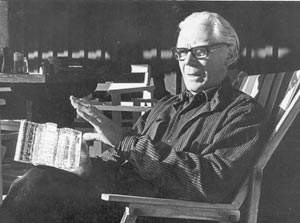| |
|
| |
 |
|
about
Born in Burlöv, south of Sweden,1906 - †1994.
1925 - 28 Studies at the College of Arts, Crafts and Design in Stockholm.
1928 - 30 Studies at the Royal Academy of Fine Arts in Stockholm , professors Carl Milles and Nils Sjögren.
1932 Studies in Paris, Académie Colarossi, Maison Watteau (Despiau) and Académie moderne (Léger).
1936 - 57 Worked as a designer for Orrefors where he developed a new technique with figures and forms in the shape of air-bubbles - the so-called Arielglass.
Study trips to France, Italy, Germany, England, Holland, Belgium, Spain, Russia, Japan, China, Hongkong, Bangkok, Manila, Ceylon, Mexico, USA.
Numerous public sculptures, in the beginning in granite, concrete or bronze, since 1961 mostly in glass/metal.
Represented with various works of art in several museums in Sweden and all over the world.
Exhibitions in the Scandinavian countries, in Paris, Milan, Antwerp, Rome, New York, Moscow, Tokyo, Mexico City.
1955 Grand Prix at the Triennal in Milan.
Edvin Öhrström was working for the railways when he decided one day to leave his job and take up sculpture. One of the first lessons he probably learnt was the difficulty of keeping a family an the earnings of his new profession. In 1936 he accepted regular employment, working for two months every year as a designer with the Orrefors glass factory; here in the words of the Art Lexicon, he created "in ariel glass a personal version of graal glass,” as well as contributing to “a renewal in engraved glass.” In company with such artists as S. Gate, E. Hald, S. Palmquist and others, Öhrström has been instrumental in giving modern Swedish glass its special qualities as well as its world-wide reputation.
Yet the former railway worker refused to be side-tracked; he never forgot that his aim was to become a sculptor. He kept on modelling with a will, sculpting in stone and plaster, casting in bronze and firing clay, as well as carving in wood. The Art Lexicon also mentions that in the 1930’s he "adopted primitivism and gave his sculptures a block-like massiveness.” It seems more probable that at that time the sculptor suceeeded in developing and mastering a plastic form-language that reflected the essential qualities of his own nature – an innate gravity which makes him equally independent of fashionable trends and aesthetic prejudice.
With his fund of creative imagination and indefatigable experimenting – often in more than one sector at the same time – it is frequently impossible for an outsider to discover exactly where he stands in relation to other designers, sculptors or painters. Yet his deep-rooted sense of form, strong decorative penchant and imaginative treatment of medium have never been in doubt. Not surprisingly his sculptures were not long in finding a place in the museums of his native land where, as time went on, he was entrusted with a great number of important commissions. Of these the greatest was the monument set up in front of the Halmstad Town Hall in 1952 to commemorate the meeting of three monarchs. In Norway Öhrström is known inter alia from his guest appearance at the State Autumn Exhibition in 1954 and ehe Nils Holgersson goose in Arne Garborg’s square.
|
|
|
    |
| |
|
|









